Dykning med Kirurgfisk og tangfisk
Koh Lantas Marineliv | Acanthuridae
Kirurgfisk, tangfisk og enhjørningfisk er 86 tropiske arter, der udgør familien Acanthuridae, og flere arter ses regelmæssigt under dykkerture på Koh Lanta.
Alle medlemmer har en dyb, sammenpresset krop med øjnene højt placeret på hovedet. Medlemmer af slægten Naso, almindeligvis kendt som enhjørningfisk, har en hornlignende fremspring foran øjet.
Medlemmerne af denne familie lever hovedsageligt på koralrev, er for det meste farvestrålende og er kendt for en eller flere farligt skarpe, skalpelagtige pigge på hver side af haleroden (caudal peduncle). Familiemedlemmer med en enkelt pig kan folde denne ind i en vandret rille på haleroden, men hos arter med mere end en pig er piggene fastlåste. De kan forsvare sig selv og skære andre fisk med et slag med halen.
Munden er lille og har en enkelt række tætstående tænder, der er tilpasset til at græsse alger. Kirurgfisk lever undertiden som ensomme individer, men de kan også ofte rejse og spise i stimer. Når de spiser i stimer, kan de let overvælde territoriale fisk såsom aggressive damselfisk, der måske bevogter små områder med alger på et koralrev.
Kirurgfisk befrugtes eksternt og kan samles i store flokke inden gydningen. De fleste kirurgfisk gyder i grupper, selvom nogle danner gydende par eller grupper af par. De er broadcast-gydere og har pelagiske æg og larver.
17 arter fundet på denne side:
- Eyestripe Surgeonfish (Acanthurus dussumieri)
- Lined Surgeonfish (Acanthurus lineatus)
- Convict Surgeonfish (Acanthurus triostegus)
- Powderblue Surgeonfish (Acanthurus leucosternon)
- Brown Surgeonfish (Acanthurus nigrofuscus)
- White-Freckled Surgeonfish (Acanthurus maculiceps)
- Blackstreak Surgeonfish (Acanthurus nigricaudus)
- Indian Mimic Surgeonfish (Acanthurus tristis)
- Yellowfin Surgeonfish (Acanthurus xanthopterus)
- Whitetail Surgeonfish (Acanthurus thompsoni)
- Orangespine Unicornfish (Naso lituratus)
- Bluespine Unicornfish (Naso unicornis)
- Bignose Unicornfish (Naso vlamingii)
- Lined Bristletooth Surgeonfish (Ctenochaetus striatus)
- Indian Gold Ring Bristletooth Tang (Ctenochaetus truncatus)
- Twospot Bristletooth Surgeonfish (Ctenochaetus binotatus)
- Brushtail Tang (Zebrasoma scopas)
Eyestripe Surgeonfish
(Acanthurus dussumieri)
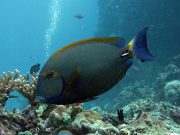
Acanthurus dussumieri @ Koh Haa
The Eyestripe Surgeonfish surgeonfish has a brownish to bluish body with many horizontal wavy lines. There is a dark yellowish stripe or blotch through the eye and the lips are lighter than the head colour. The dorsal and anal fins are mostly yellow, with a blue patch at the rear. The tail fin base is yellowish-whitish, and the tail is mostly blue with many dark spots.
The Eyestripe Surgeonfish grows to 50 cm, but more often observed around 30 cm - 35 cm. This species is usually seen alone, but sometimes forms small groups.
Lined Surgeonfish
(Acanthurus lineatus)
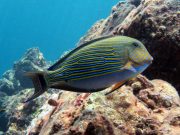
Acanthurus lineatus @ Koh Haa
The Lined Surgeonfish, or Striped Surgeonfish has a yellow body and golden head, with a pale grey underbody or belly. There are many horizontal black-edged blue stripes along the body, with similar diagonal stripes on the head and radiating from the eye. The pectoral fin shares the same black-edged blue stripe markings. The pelvic fin is yellow with a dark margin, and the dorsal and tail fins are dark. There are one or more black-edged vertical blue bands on the tail base.
The Lined Surgeonfish grows to 38 cm, but more usually observed in the 20 cm - 25 cm range. Often seen in small to medium sized groups, usually in shallower parts of the reef around rocky valleys and algae rich surfaces. The tailfin spine is venomous and causes painful wounds.
Convict Surgeonfish
(Acanthurus triostegus)

Acanthurus triostegus @ Koh Rok
The Convict Surgeonfish has a pale yellowish upper body and whitish lower body with 5 - 6 vertical black bars. The forward-most bar is always through the eye, and there is a small black band from the forehead to the snout.
The Convict Surgeonfish grows to 25 cm and can occasionally be seen feeding in small groups among the shallow reef areas at Koh Rok.
This species is very rarely seen at any of our other dive sites.
Powderblue Surgeonfish
(Acanthurus leucosternon)

Acanthurus leucosternon @ Koh Haa
The Powderblue Surgeonfish has a black head with white patch below in the 'neck' area, and a power-blue body. The dorsal fin and tail fin base are yellow, and the pelvic and snal fins are white.
The Powderblue Surgeonfish grows to 38 cm, but more usually observed in the 15 cm - 20 cm range. This species is a common sight at the dive sites around Koh Lanta and can be seen alone, or in small groups.
Brown Surgeonfish
(Acanthurus nigrofuscus)

Acanthurus nigrofuscus @ Koh Haa
The Brown Surgeonfish has a lavender to tan to brown body. The head may be dark, or a pale greyish-bluish colour.
There are many fine spots on the head and chest area, which may be orangish to bluish-white in colour.
The body may have many fine bluish grey horizontal lines. All colour variations have a black spot at the rear base of the last dorsal and anal fin rays.
The Brown Surgeonfish grows to 21 cm and is one of the smallest of the surgeonfishes. This species feeds on algae grazed from rocky surfaces, sometimes in small schools.
White-Freckled Surgeonfish
(Acanthurus maculiceps)

Acanthurus maculiceps @ Koh Haa
The White-Freckled Surgeonfish has a black head with numerous white spots and a pale to dark grey body.
There is a small black streak behind the top of the gill cover, and the pectoral fin may have a yellow tip.
The tail fin is dark, often with a vertical white stripe on the tail fin base. The tail spine has a black margin.
The White-Freckled Surgeonfish grows to 40 cm, but more usually observed 20 cm - 25 cm in length.
This species is usually observed solitary, but may form small groups from time to time.
Blackstreak Surgeonfish
(Acanthurus nigricaudus)

Acanthurus nigricaudus @ Koh Haa
The Blackstreak Surgeonfish has a pale grey to brown to near-black coloured body and a long black streak or bar behind the eye to above the pectoral fin.
There is often (but not always) a thin dark streak on the rear body to the tail fin base. The tail fin base has a vertical white bar, and the pectoral fin often has a yellow margin.
The Blackstreak Surgeonfish grows to 40 cm, but usually observed around 25 cm - 30 cm.
This species can be found over sandy and rubble areas at the edge of coral rich areas.
Indian Mimic Surgeonfish
(Acanthurus tristis)
The Indian Mimic Surgeonfish has a tan to dark brown body, with a grey face. There is a curving black band from under the mouth to the top of the gill cover and a black patch over the pectoral fin base.
There is a small white or pale grey bar from the chin to the upper lip, just behind the mouth opening. The tail is dark and has a thin white or yellowish margin.
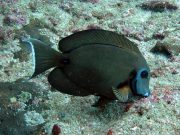
Acanthurus tristis @ Koh Haa
Juveniles have very similar colouring to the Blacktail Angelfish (Centropyge eibli).

Indian Mimic Surgeonfish @ Koh Haa
Indian Mimic Surgeonfish grow to 25 cm and are often seen around Koh Haa Lagoon and other sandy areas close to rich coral reefs.
Yellowfin Surgeonfish
(Acanthurus xanthopterus)

Acanthurus xanthopterus @ Koh Haa
The Yellowfin Surgeonfish has a grey to greyish-brown to bluish body. The pectoral fins are yellow to yellowish and there is a yellow band passing through the eye.
There may be a white ring around the tail, however this is not always present. The dorsal and anal fins may have a hint of yellow margin to them, and the tail fin lobes are elongate.
The Yellowfin Surgeonfish grows to 56 cm and is the largest of all surgeonfish.
This species can be seen solitary, or in small groups feeding in sandy areas near the reef edge. Often seen in deeper areas outside The Lagoon at Koh Haa, or off the south east / east side of Koh Haa Yai.
Whitetail Surgeonfish
(Acanthurus thompsoni)

Acanthurus thompsoni @ Koh Haa
The Whitetail Surgeonfish has a uniformly dark body colour, very dark blue to dark brown, with a snow-white tail fin. The pectoral fins may have a yellowish tinge.
The Whitetail Surgeonfish grows up to 27 cm and may change colour when disturbed.
This is a rarely observed species at the Koh Lanta dive sites.
Orangespine Unicornfish
(Naso lituratus)
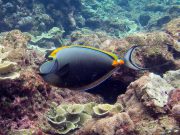
Naso lituratus @ Koh Haa
The Orangespine Unicornfish has a brownish-grey to dark-grey body, is yellow above the eyes and has a yellow-edged black area from the mouth to the eye. The lips are usually orange. There is a pair of bright orange tail fin spines on each side.
There is usually no horn-like projection on this species, however some rare individuals do have a very small black horn-like projection between the eyes.
The Orangespine Unicornfish grows to 46 cm, but more usually observed around 25 cm - 30 cm.
Bluespine Unicornfish
(Naso unicornis)

Naso unicornis @ Koh Haa
The Bluespine Unicornfish has a greyish-blue to olive-blue body, slightly darker on the upper body and lighter on the lower body. The tail is dark, with a light margin, and the tail fin lobes are extended. The double tail fin spines are bright blue. There is a short horn between the eyes which does not extend past the snout.
The Bluespine Unicornfish grows to 70 cm, but usually observed in the 25 cm - 35 cm range. This species feed on algae and is usually seen in shallow water over coral rich areas and over sand close to coral rich areas. The diet includes coarse leafy brown algae seaweeds such as Sargassum.
Bignose Unicornfish
(Naso vlamingii)

Naso vlamingii @ Hin Daeng
The Bignose Unicornfish has a blue to brown body with a dark horizontal stripe extending from the eye to a large bump on the head.
The side of the body has many thin horizontal lines which become rows of spots on the upper body.
The forward eye stripe and body stripes can be changed from brown to blue at will, with brown being the camouflage colour.
The Bignose Unicornfish has tall dorsal and anal fins and the tail fin has long trailing filaments on the top and bottom. This species has a double spine at the tail fin base.
The Bignose Unicornfish grows to 60 cm and the diet includes zooplankton.
Lined Bristletooth Surgeonfish
(Ctenochaetus striatus)
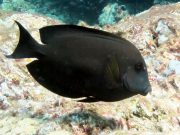
Ctenochaetus striatus @ Koh Haa
The Lined Bristletooth Surgeonfish has a generally dark olive to yellowish brown body, with many faint orange spots around the eye and forehead. The body has many faint, fine wavy horizontal blue lines. There is often a white or pale blue spot on the head, directly in front of the eyes, and possibly also under the chin. Juveniles and small adults may also have a small black spot at the rear base of the dorsal fin.
The Lined Bristletooth Surgeonfish grows to 26 cm, but more usually observed 15 cm - 18 cm. The diet includes several species of toxic algae, and these toxins accumulate in the body, making this a poisonous fish to eat.
Indian Gold Ring Bristletooth Tang
(Ctenochaetus truncatus)

Ctenochaetus truncatus @ Koh Haa
The Indian Gold Ring Bristletooth Tang has an olive-brownish to dark grey body completely covered in hundreds of tiny light blue to yellowish spots.
The spots merge on some parts of the body to form short wavy lines. The top of the eye is yellow.
The pectoral fin is translucent yellowish. The rear of the dorsal and anal fins are angular.
The Indian Gold Ring Bristletooth Tang grows to more than 25 cm. This is a poorly documented species.
Twospot Bristletooth Surgeonfish
(Ctenochaetus binotatus)
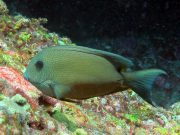
Ctenochaetus binotatus @ Koh Haa
The Twospot Bristletooth Surgeonfish has an olive-brown to orangish-brown body with many whitish to orangish spots on the head, becoming almost wavy lines along the length of the body and on to the tail base.
There is a black spot at the rear of the dorsal fin base and anal fin base. The tail can be olive-greenish to yellowish.
The Twospot Bristletooth Surgeonfish grows to 22 cm, but usually observed in the 15 cm to 18 cm range.
As with several other surgeonfishes, the diet includes some species of algae which are toxic. These toxins can accumulate within the body over time and eating this fish is not recommended.
Brushtail Tang
(Zebrasoma scopas)
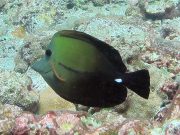
Zebrasoma scopas @ Koh Haa
The Brushtail Tang, sometimes known as the Two-Tone Tang, has a yellowish brown head and forebody, gradating to nearly black on the tail. The eye is black and the pectoral fin is lightly coloured.
There is a dark patch of brush-like bristles in front of the bright white tail spine. There are many small pale blue to blue-green spots and wavy lines on the head and body.
The Brushtail Tang grows to 20 cm, but usually observed around 12 cm - 15 cm. This species can be solitary or form pairs for breeding.
Dykning med Kirurgfisk og tangfisk omkring Koh Lanta
Dykning og snorkelture
Hvis du gerne vil have chancen for at se Kirurgfisk og tangfisk på en af vores daglige dykkerture i højsæsonen fra Koh Lanta, så send os en e-mail til info@diveandrelax.com.
Deltag i vores speedbådsdykkerture i højsæsonen til nogle af Thailands bedste dykkersteder og nyd små grupper, korte rejsetider med fokus på god personlig service, sikkerhed og sjov.
Er du endnu ikke certificeret dykker? Lær at dykke på Koh Lanta med det 3-dages SSI Open Water Diver-kursus.
Book online og spar 10% på dykkerture og dykkerkurser på Koh Lanta.
Få mere at vide
Indo-Stillehavets havdyrsguider
- Allen, G., Steene, R., Humann, P., DeLoach, N. (2003) Reef Fish Identification, Tropical Pacific. Jacksonville, FL., USA: New World Publications, Inc., ISBN 1-878348-36-1.
- Humann, P., DeLoach, N., (2010) Reef Creature Identification, Tropical Pacific. Jacksonville, FL., USA: New World Publications Inc., ISBN 978-1-878348-44-9
- Debelius, H. (2013) Indian Ocean Reef Guide. Frankfurt, Germany: IKAN - Unterwasserarchiv, ISBN 978-3-939767-52-7.
- Debelius, H. (2004) Nudibranchs and Sea Snails, Indo-Pacific Field Guide. Frankfurt, Germany: IKAN - Unterwasserarchiv, ISBN 3-925919-51-1
- Erhardt, H., Knop, D. (2015) Corals Indo-Pacific Field Guide. Frankfurt, Germany: IKAN - Unterwasserarchiv, ISBN 3-925919-69-4.
- Veron J.E.N., Stafford-Smith M.G., Turak E. and DeVantier L.M. (2016). Corals of the World
Flere referencer om havets dyreliv og yderligere information
